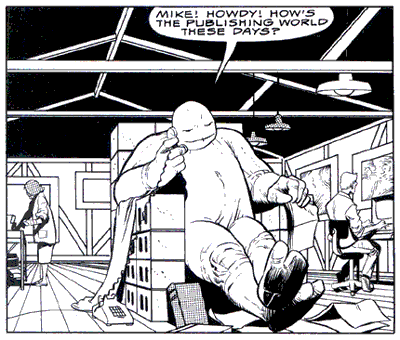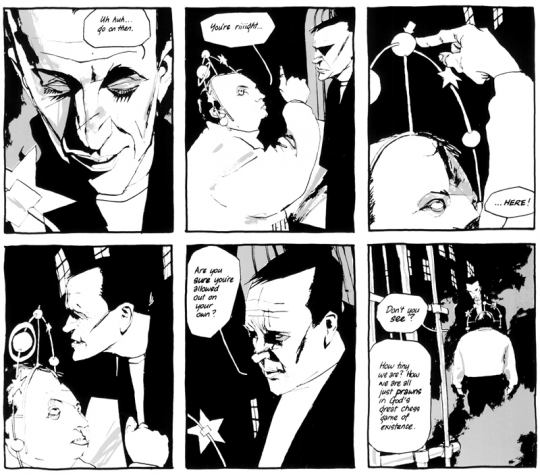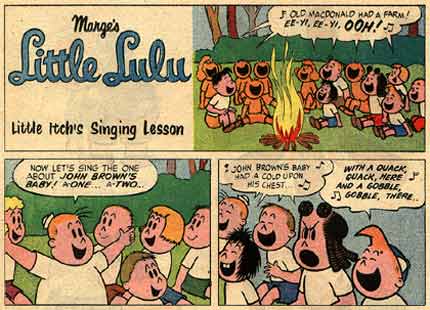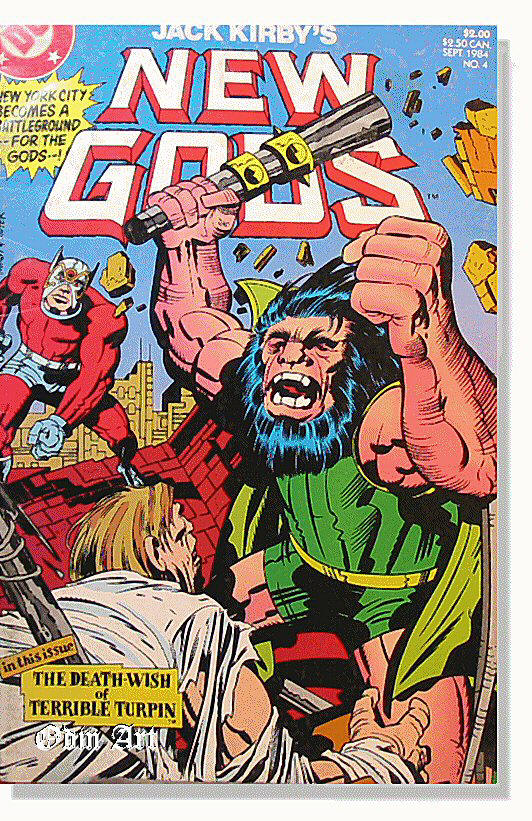The following lists were submitted in response to the question, “What are the ten comics works you consider your favorites, the best, or the most significant?” All lists have been edited for consistency, clarity, and to fix minor copy errors. Unranked lists are alphabetized by title. In instances where the vote varies somewhat with the Top 115 entry the vote was counted towards, an explanation of how the vote was counted appears below it.
In the case of divided votes, only works fitting the description that received multiple votes on their own received the benefit. For example, in Jessica Abel’s list, she voted for The Post-Superhero comics of David Mazzucchelli. That vote was divided evenly between Asterios Polyp and Paul Auster’s City of Glass because they fit that description and received multiple votes on their own. It was not in any way applied to the The Rubber Blanket Stories because that material did not receive multiple votes from other participants.
Katherine Dacey
Writer, The Manga Critic
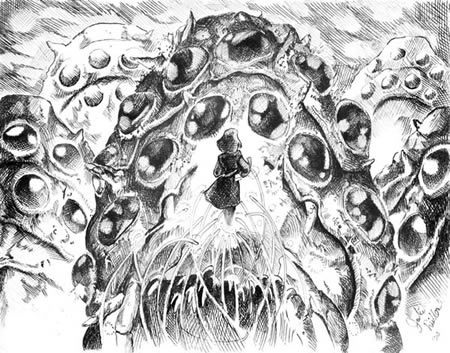
Nausicaä of the Valley of the Wind, Hayao Miyazaki
- The Arrival, Shaun Tan
- Emma, Kaoru Mori
- The Far Side, Gary Larson
- Hi no Tori [Phoenix], Osamu Tezuka
- Kaze no Tani no Naushika [Nausicäa of the Valley of the Wind], Hayao Miyazaki
- The New Yorker cartoons, Charles Addams
- Peanuts, Charles M. Schulz
- Persepolis, Marjane Satrapi
- Satsuma Gishiden, Hiroshi Hirata
- Swan, Kyoko Ariyoshi
______________________________________________
Marco D’Angelo
Writer, Sono Storie
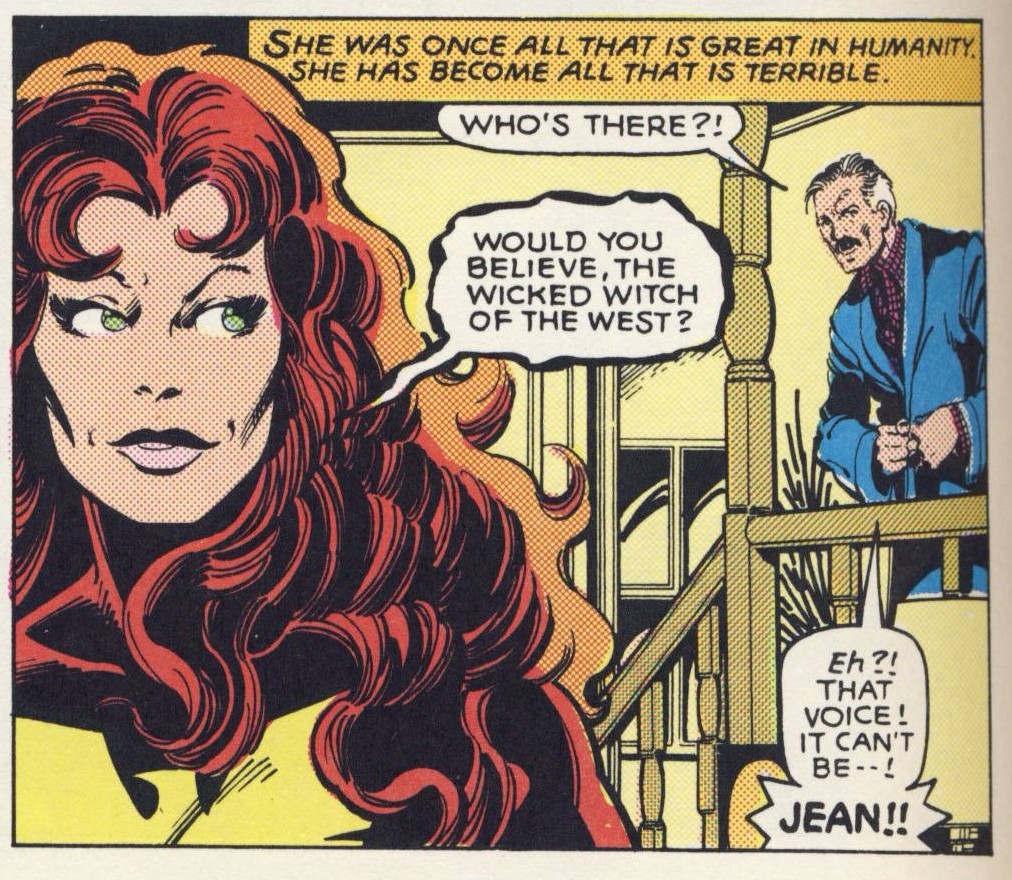
X-Men, Chris Claremont & John Byrne
- Astérix le gaulois [Astérix the Gaul], René Goscinny & Albert Uderzo
- Corto Maltese: Una balata del mare salato [The Ballad of the Salt Sea], Hugo Pratt
- Daredevil: Born Again, Frank Miller & David Mazzucchelli
- El Eternauta, Héctor Germán Oesterheld & Francisco Solano Lopéz
- Flash Gordon, Alex Raymond
- Ken Parker: Lily e il cacciatore [Lily and the Hunter], Giancarlo Berardi & Ivo Milazzo
- Paperino e il vento del sud [Donald Duck and the Southern Wind], Giovan Battista Carpi
- Tex Willer: Il figlio di Mephisto [Mephisto’s Son], Gianluigi Bonelli & Aurelio “Galep” Galleppini
- Watchmen, Alan Moore & Dave Gibbons
- X-Men: The Dark Phoenix Saga, Chris Claremont & John Byrne, with Terry Austin
______________________________________________
Alexander Danner
Instructor, Emerson College; contributing writer, ComixTalk
- Buddha, Osamu Tezuka
- Castle Waiting, Linda Medley
- Le Chat du rabbin [The Rabbi’s Cat], Joann Sfar
- Dicebox, Jenn Manley Lee
- Dykes to Watch Out For, Alison Bechdel
- Family Man, Dylan Meconis
- Finder, Carla Speed McNeil
- Hereville, Barry Deutsch
- Pluto, Naoki Urasawa
- Three Shadows, Cyril Pedrosa
______________________________________________
Mike Dawson
Cartoonist, Gabagool!, Freddie & Me, and Ace-Face: The Mod with the Metal Arms
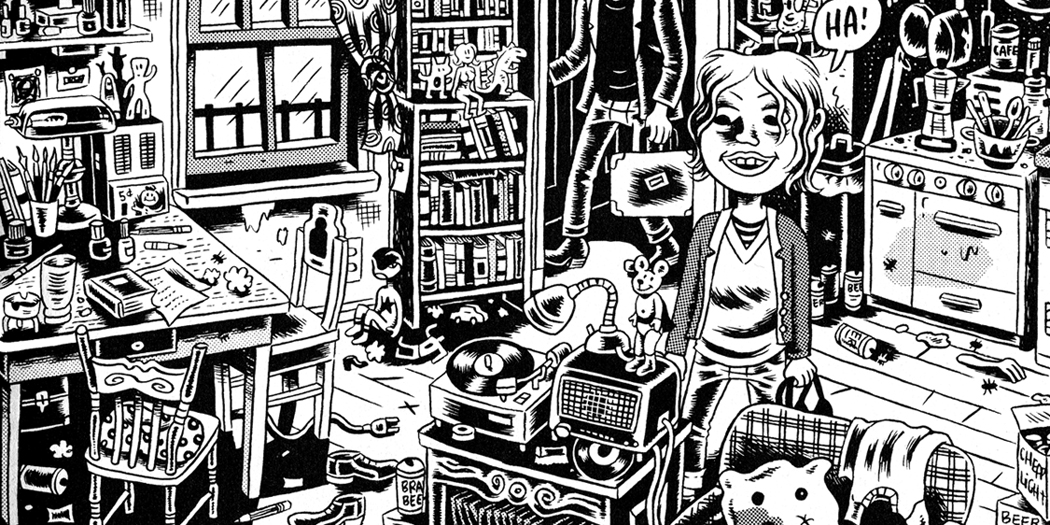
My New York Diary, Julie Doucet
- The ACME Novelty Library, Chris Ware, especially issues #17, 18, and 19
Counted as a 0.5 vote each for “Building Stories” and Rusty Brown, including “Lint”. - Hicksville, Dylan Horrocks
- It’s a Good Life, If You Don’t Weaken, Seth
- Love and Rockets, Gilbert Hernandez & Jaime Hernandez, especially “Flies on the Ceiling” and The Death of Speedy
Counted as a vote for The Locas Stories, Jaime Hernandez - Maus: A Survivor’s Tale, Art Spiegelman
- My New York Diary, Julie Doucet
- The Playboy and I Never Liked You, Chester Brown
Counted as a 0.5 vote for each work - The Poor Bastard, Joe Matt
- Skyscrapers of the Midwest, Joshua Cotter
- Spaniel Rage, Vanessa Davis
______________________________________________
Kim Deitch
Cartoonist, The Search for Smilin’ Ed, The Boulevard of Broken Dreams, Alias the Cat
- 1. The Book of Genesis Illustrated, R. Crumb
- 2. Palestine, Joe Sacco
- 3. Wimbledon Green, Seth
- 4. Little Orphan Annie, Harold Gray
- 5. The Donald Duck Stories, Carl Barks
- 6. Dick Tracy, Chester Gould
- 7. Supermen!, Greg Sadowski, editor
- 8. The Marvel Universe as drawn by Jack Kirby, Steve Ditko, and Bill Everett
Counted as a 0.333 vote each for The Fantastic Four, Stan Lee & Jack Kirby, with Joe Sinnott, et al., Spider-Man, Stan Lee & Steve Ditko, and Thor, including “Tales of Asgard,” by Stan Lee & Jack Kirby, with Vince Colletta, et al. - 9. The Wolverton Bible, Basil Wolverton
- 10. Cleveland, Harvey Pekar & Joseph Remnant
Counted as a vote for American Splendor, Harvey Pekar, with R. Crumb, et al.
COMMENTS
This is in no particular order.
Well, Genesis by Crumb would be number one.
And Palestine by Joe Sacco might be number two, but then I haven’t read his newest book.
Wimbledon Green was awfully good.
I have not read it yet, but what I have seen so far of Harvey Pekar’s posthumous book Cleveland, illustrated by Joseph Remnant, looks very promising.
Lots of other comic books by Crumb could be included. I think the strip “August 1976,” by Nina Bunjevac, that recently ran in Mineshaft magazine was quite excellent. I know I’m leaving out a ton of things.
______________________________________________
Martin de la Iglesia
Contributing Writer, International Journal of Comic Art

The Walking Man, Jiro Taniguchi
- Akira, Katsuhiro Otomo
- Aruku Hito [The Walking Man], Jiro Taniguchi
- Calvin and Hobbes, Bill Watterson
- Dungeon [Donjon], Joann Sfar & Lewis Trondheim
- Garfield, Jim Davis
- Gaston Lagaffe, André Franquin
- Die seltsamen Abenteuer der Ente Alfred Jodocus Kwak [The Extraordinary Adventures of the Duck Alfred Jodocus Kwak], Hermann van Veen, Harald Siepermann, and Hans Bacher
- Subnormality, Winston Rowntree
- Tintin, Hergé
- Wir können ja Freunde bleiben [We Can Still Be Friends], Mawil
______________________________________________
Camilla d’Errico
Cartoonist, Tanpopo, Helmetgirls
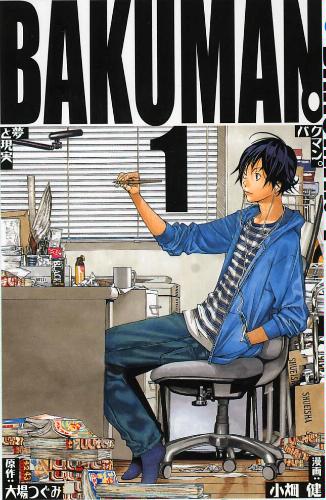
Bakuman, Tsugumi Ohba and Takeshi Obata
- Bakuman., Tsugumi Ohba & Takeshi Obata
- Blatta [Cockroach], Alberto Ponicelli
- Hôrô Musuko [Wandering Son], Takako Shimura
- Kobato., CLAMP
- Natsume Yûjinchô [Natsume’s Book of Friends], Yuki Midorikawa
- Sky Doll, Barbara Canepa & Alessandro Barbucci
- Unknown Soldier, Joshua Dysart, et al.
- The Walking Dead, Robert Kirkman & Tony Moore and Charles Adlard
______________________________________________
Francis DiMenno
Director, Emily Williston Memorial Library and Museum; contributing writer, The Lemon Basket
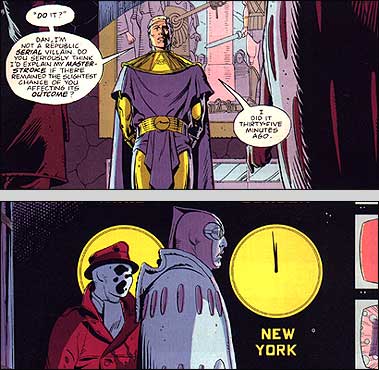
Watchmen, Alan Moore & Dave Gibbons
- Abbie an’ Slats, Al Capp & Raeburn Van Buren, with Elliot Caplin
- The Complete Crumb Comics, Volumes 1-17, R. Crumb
Counted as a vote for The Counterculture-Era Stories, R. Crumb [see comments]. - Dick Tracy, Chester Gould
- Krazy Kat, George Herriman
- Little Orphan Annie, Harold Gray
- MAD #1-28, Harvey Kurtzman & Will Elder, Wallace Wood, Jack Davis, et al.
- The Original Nexus, Mike Baron & Steve Rude
- Pogo, Walt Kelly
- Spider-Man, Stan Lee & Steve Ditko
- Watchmen, Alan Moore & Dave Gibbons
COMMENTS
If obliged to select only one [of The Complete Crumb editions], I would select Volume 6, “On the Crest of a Wave”. If this is not suitable, than I would select Robert Crumb’s body of work in Zap Comix.
Watchmen, A Brief Appreciation
I don’t want to brag, but I spotted Alan Moore as a genius right around the time of “Whatever Happened to the Man of Tomorrow?” I showed that particular story to all my friends. You can ask them.
And Watchmen was a signal accomplishment for its time, right up there with Frank Miller’s Batman: The Dark Knight Returns, Rônin, and Daredevil: Born Again. It still holds up well over 25 years later. It is still one of the few graphic novels with the density and complexity of a good novel.
Quite frankly, I’ve made this peculiar sub-genre of literature my field of study for over 40 years. (Yup, I’m that old.) Watchmen is at or very near the top of the heap as far as I’m concerned.
Moore himself would probably tell you himself that he is thoroughly steeped in comics lore, and that he borrowed quite a few of the genre’s tropes to tell his story. Harold Bloom called it “the anxiety of influence.” It’s not by any means a bad thing. Nearly all authors draw upon genre conventions of one kind or another to tell their stories. What really counts in the end is how they use those narrative conventions.
Watchmen will stand because it was one of the very first self-aware works of graphic art, and one of the very first graphic novels truly worthy of the name…
______________________________________________
Alan David Doane
Publisher/editor, Comic Book Galaxy; writer, Trouble with Comics, The ADD Blog
- American Elf, James Kolchalka
- American Splendor, Harvey Pekar, et al.
- Daredevil: Born Again, Frank Miller & David Mazzucchelli
- Diary of a Teenage Girl, Phoebe Gloeckner
- From Hell, Alan Moore & Eddie Campbell
- Ice Haven, Daniel Clowes
- “Master Race,” Bernard Krigstein & Al Feldstein
- The New Gods, Jack Kirby, with Mike Royer, et al.
Counted as a vote for The Fourth World Stories, Jack Kirby, with Mike Royer, et al. - Peanuts, Charles M. Schulz
- Spider-Man, Stan Lee & Steve Ditko
______________________________________________
Randy DuBurke
Cartoonist, Hunter’s Heart; illustrator, Malcolm X: A Graphic Biography, Yummy: The Last Days of a Southside Shorty
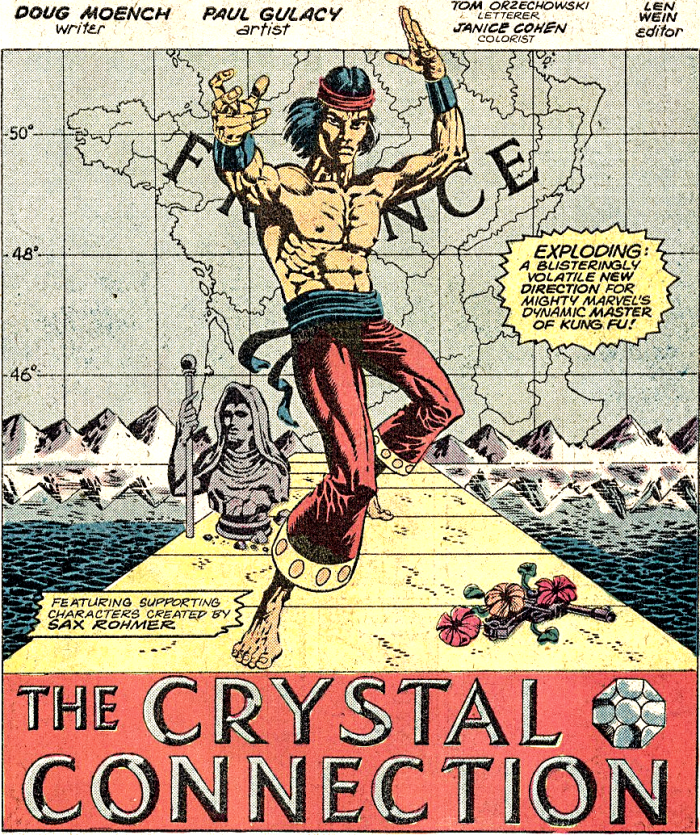
Master of Kung Fu, Doug Moench & Paul Gulacy
- 1. Mort Cinder, Héctor Germán Oesterheld & Alberto Breccia
- 2. Il collezionista [The Collector], Sergio Toppi
- 3. Nova-2, Louis Garcia Mozos
- 4. The Spirit, Will Eisner
- 5. Chandler: Red Tide, Jim Steranko
- 6. Master of Kung Fu, Doug Moench & Paul Gulacy
- 7. Elektra: Assassin, Frank Miller & Bill Sienkiewicz
- 8. Swamp Thing, Len Wein & Bernie Wrightson
- 9. The Swamp Thing Stories, Alan Moore & Stephen R. Bissette, John Totleben, Rick Veitch, et al.
- 10. Thriller, Robert Loren Fleming & Trevor von Eeden
______________________________________________
Randy Duncan
Professor of Communication & Theatre Arts, Henderson State University
- 1. The Fantastic Four, Stan Lee & Jack Kirby, with Joe Sinnott, et al.
- 2. Calvin and Hobbes, Bill Watterson
- 3. New York: The Big City, Will Eisner
- 4. The Daredevil Stories, Frank Miller & Klaus Janson
- 5. Blankets, Craig Thompson
- 6. The Spider-Man Stories, Stan Lee & John Romita, with Jim Mooney, et al.
- 7. The Conan the Barbarian Stories, Roy Thomas & John Buscema, with Ernie Chan (né Chua), et al.
- 8. Cerebus, Dave Sim & Gerhard
- 9. Asterios Polyp, David Mazzucchelli
- 10. Concrete, Paul Chadwick
COMMENTS
This list is not designed to impress anyone with my “good taste.” It is not meant to be a canon-building exercise based on an objective standard of quality. It is a very subjective list of work in comics form that has been (and, in most cases, continues to be) important to me.
Formalist that I am, sometimes I am responding to the intellectual experience of appreciating skillful, even innovative, use of the comics form (3, 4, 5, 8, 9).
In other instances it is an emotional experience of connecting with characters (2, 6, 7, 10).
A couple of the comics provide me with the sublime experience of being transported to fantastic worlds by the audacity of the concepts and the power of the artwork (1, 7).
_____________________________
Kathleen Dunley
Faculty Chair, English, ESL, Reading & Creative Writing, Rio Salado College
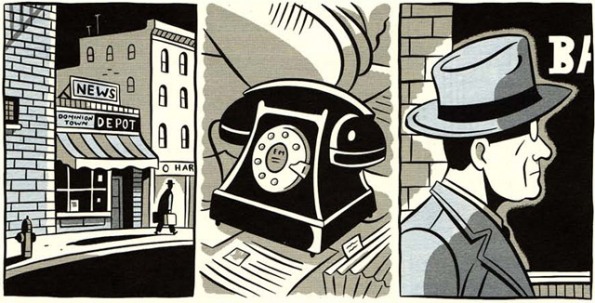
It’s a Good Life, If You Don’t Weaken, Seth
- 1. It’s a Good Life, If You Don’t Weaken, Seth
- 2. The ACME Novelty Library, Chris Ware
Counted as a vote for “Building Stories”, Chris Ware [see comments] - 3. Paying For It, Chester Brown
- 4. “Here,” Richard McGuire
- 5. Little Nemo in Slumberland, Winsor McCay
- 6. Gasoline Alley, Frank King
- 7. Dykes to Watch Out For, Alison Bechdel
- 8. Paper Rodeo, Fort Thunder Collective
- 9. Promethea, Alan Moore & J. H. Williams III, with Mick Gray, et al.
- 10. Bodyworlds, Dash Shaw
COMMENTS
[About the vote for The ACME Novelty Library] If I have to narrow it, I’d say Volume 18 [“Building Stories”].
______________________________________________
Paul Dwyer
Cartoonist, I Shot Roy!
- Banks/Eubanks, Tom Hart
- Cages, Dave McKean
- Feiffer, Jules Feiffer
- “Here,”, Richard McGuire
- Krazy Kat, George Herriman
- Peanuts, Charles M. Schulz
- Real Dreams: Photostories, Duane Michals
- Une Semaine de bonté [A Week of Kindness], Max Ernst
- What Am I Doing Here?, Abner Dean
- Zippy the Pinhead, Bill Griffith
______________________________________________
Joshua Dysart
Scriptwriter, Violent Messiahs, Unknown Soldier, Neil Young’s Greendale
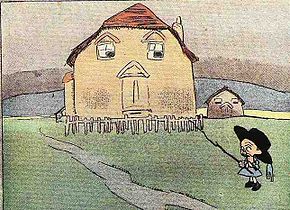
Wee Willie Winkie’s World, Lyonel Feininger
- 1. From Hell, Alan Moore & Eddie Campbell
- 2. Wee Willie Winkie’s World, Lyonel Feininger
- 3. Swamp Thing, Len Wein & Bernie Wrightson
- 4. Zap Comix, R. Crumb, S. Clay Wilson, Robert Williams, Spain Rodriguez, Gilbert Shelton, Victor Moscoso, and Rick Griffin
Counted as a vote for The Counterculture-Era Stories, R. Crumb - 5. Little Nemo in Slumberland, Winsor McCay
- 6. Cerebus, Dave Sim & Gerhard
- 7. Dark Horse Presents, Randy Stradley, ed.
- 8. The Silver Surfer Stories, Stan Lee & John Buscema, with Jack Kirby, et al., and The Silver Surfer Graphic Novel, Stan Lee & Jack Kirby
- 9. RAW, Art Spiegelman & Françoise Mouly, eds.
Counted as a 0.125 vote each for: The Alack Sinner and Le Bar à Joe [Joe’s Bar] Stories, José Muñoz & Carlos Sampayo; The Autobiographical Stories, Aline Kominsky-Crumb; Ernie Pook’s Comeek and The RAW Stories, Lynda Barry; “Here,” Richard McGuire; The Jimbo Stories, Gary Panter; Maus: A Survivor’s Tale, Art Spiegelman; Quimby the Mouse, Chris Ware; The Weirdo-Era Stories, R. Crumb - 10. Concrete, Paul Chadwick
COMMENTS
But I just can’t do ten. It’s driving me crazy…
11. Journey, William Messner-Loebs; 12. Wasteland, John Ostrander & Del Close, et al.; 13. The Tale of One Bad Rat, Bryan Talbot; 14. The Spirit, Will Eisner; 15. Love and Rockets, Gilbert Hernandez & Jaime Hernandez; 16. American Flagg!, Howard Chaykin; 17. Two-Fisted Tales, Harvey Kurtzman & Jack Davis, John Severin, Wallace Wood, et al.; 18. Dalgoda, Jan Strnad & Dennis Fujitake; 19. Krazy Kat, George Herriman; 20. Luther Arkwright, Bryan Talbot; 21. The Frank stories, Jim Woodring; 22. Roarin’ Rick’s Rarebit Fiends, Rick Veitch; 23. Bacchus, Eddie Campbell; 24. Kozure Ôkami [Lone Wolf and Cub], Kazuo Koike & Goseki Kojima; 25. Eightball, Daniel Clowes; 26. MAD #1-28, Harvey Kurtzman & Will Elder, Wallace Wood, Jack Davis, et al.; 27. Nexus, Mike Baron & Steve Rude, with Gary Martin, et al.
______________________________________________
Joe Eisma
Illustrator, Existence 2.0/3.0, Morning Glories
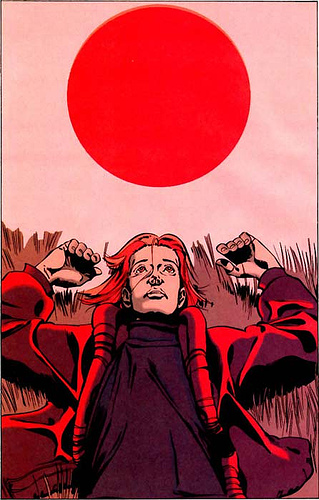
The Invisibles, Grant Morrison, et al.
- Carnet de Voyage, Craig Thompson
- The Death of Captain Marvel, Jim Starlin
- The Invisibles, Grant Morrison & Phil Jiminez
- Local, Brian Wood & Ryan Kelly
- Nijusseiki Shônen [20th Century Boys], Naoki Urasawa
- Pluto, Naoki Urasawa
- Stray Bullets, David Lapham
- X-Men: God Loves, Man Kills, Chris Claremont & Brent Anderson
- The X-Men Stories, Chris Claremont & Paul Smith, with Bob Wiacek
______________________________________________
Austin English
Cartoonist, Christina and Charles
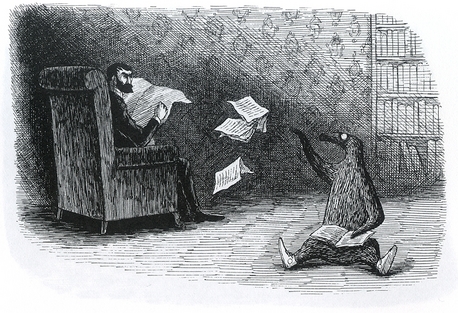
The Doubtful Guest, Edward Gorey
- Aruku Hito [The Walking Man], Jiro Taniguchi
- The Autobiographical Comics, Luc Leplae
- Chimera, Lorenzo Mattotti
- Vie et mort du héros triomphante [The Hero’s Life and Death Triumphant], Frédéric Coché
- The Kin-der-Kids, Lyonel Feininger
- Krazy Kat, George Herriman
- Leben? oder Theater?: Ein Singespiel [Life? Or Theater?: A Singspiel], Charlotte Salomon
- Der Palast [The Palace], Anke Feuchtenberger
- White Boy, Garrett Price
- Works, Edward Gorey
COMMENTS
Leben? oder Theater?: Ein Singspiel, by Charlotte Salomon. This work is usually talked about due to the tragic circumstances surrounding its creation and ultimate fate of its author. I remember seeing it before reading about Salomon’s biography and was filled with inspiration for the way Salomon drew figures and poses as I struggled to find my own way to draw characters in a picture story. This is a singular work in so many ways: a long narrative drawn in a rich way that most long comic narratives would shy away from. There is also an intensity of emotion that you can’t miss even before you know the situation the work was born into. So, for its sustained richness of images and unembarrassed emotional force, this work seems to tower above almost every other work of graphic narrative. Somehow its example has been ignored, perhaps because its too strong to grapple with.
Chimera by Lorenzo Mattotti. I enjoy looking at the neat panel borders in this comic, and then shifting my attention to the flurry of lines within those neat borders. I like to imagine the borders sketched out first, as little areas for Mattotti to pour out his heartbreaking work. I don’t know if he comes at those panels unleashing a torrent of jagged lines or if he methodically applies each stroke in a systematic way. Either way, Mattotti’s system is not just thrilling to read and digest, but enriching to anyone who attaches any value to the idea that one can express ones self through drawing.
Der Palast by Anke Feuchtenberger. Hard to narrow down one Feuchtenberger work for this list. As a reader, I prefer her W the Whore work. But this album is something of a perfect object: the long size of the book and the shape of the characters. The imagery is “personal” (who else could it have come from except for Feuchtenberger) but also communicates something that is not about unadulterated expression. As in many of my favorite works of art, the drawings are labored over not to achieve perfection, but to achieve shapes that convey a world of thought and feelings beyond the narrow scope of our brains. These drawings are for our hearts, all the parts of it.
Hero’s Life and Death Triumphant by Frédéric Coché. For the scale, the ambition, and for the heroic achievement, this work has to be on a ten best list, even if I find it somewhat lacking as a story. The overall punch of it is enough: page after page of gorgeous etched comics. Comics are always hard work, and the noble effort of this volume is always inspiring to me.
The White Boy page by Garrett Price from the Smithsonian collection. Specifically, I’m talking about the page with the large bottom portion featuring a richly drawn sky. That single page seems to be a secret influence lurking over the ambitions of many a contemporary cartoonist: the simplicity of the figures combined with the devil-may-care attitude that went into the drawing of the landscape.
The Kin-der-Kids by Lyonel Feininger. I prefer it to Little Nemo by a long shot. I find it more interesting on a technical drawing level, and the shapes to be far more pleasing aesthetically. Most of all, it has the visual bravado of Nemo, but it happens to be full of beautiful writing and stories. A pity that it was out of print for so long, only to be reprinted to mass indifference.
Krazy Kat by George Herriman. My Krazy Kat collections will never be sold when I’m short on money or left behind when I move. I’ll keep going back to them for my entire life. When I’m feeling down, they make me happy. When I want to see some imaginative drawings, I know there will always be something in them that I missed before. When I want to see everything that comics can be—a world totally with its own laws of language, design, and logic that is still more inviting than intimidating—Krazy Kat is what I always want to go to first. As a work of art that makes you feel alive as a human and as an artist, Krazy Kat is still my favorite.
The complete works of Edward Gorey. The last page in the last big Gorey collection is a heartbreak: a ruled page, awaiting detail. Gorey kept making books, and I can’t think of a clunker. Together, they are full of all kinds of stories, all kinds of shapes and figures. The scope of Gorey’s ideas and tones are so vast that I don’t understand why he isn’t talked about more in comics circles. Often, with someone of Gorey’s caliber, I have the sinking suspicion that the work is “too good” to be engaged in comics terms. It has such a distance from the rest of the pack that it becomes to seem like a strange anomaly.
The Walking Man by Jiro Taniguchi. Hard to limit myself to one work of manga, but this one always leaps to mind first. I sometimes have the guilty feeling of liking Taniguchi more than Hergé, and this is the work that usually pushes me into that thinking (Hergé would have never let himself release a book this eccentric). I admire this book as an example of “perfect” comics drawing (more perfect to me than Jamie Hernandez), but it’s the writing that gets it on the top ten list. An achingly calm story punctuated by moments of small action that feel monumental, this is a book that shows day-to-day life as not mundane but thrillingly odd.
The autobiographical comics of Luc Leplae. I look at a lot of comics, and I yearn for more like these. The figures are drawn in a unique style, and you can see Leplae’s brain trying to figure out the basics: Where should I put text? How many drawings on one page? I suspect that if he had been in contact with other cartoonists, his style would have become more refined, more readable. And that would have been fine—I like refined comics a lot. But I also like the thrilling originality of this work, and the energy that comes from it.
______________________________________________
Jackie Estrada
Co-publisher, Exhibit A Press; administrator, The Will Eisner Comic Industry Awards
- The Donald Duck and Uncle $crooge Stories, Carl Barks
- Ernie Pook’s Comeek, Lynda Barry
- Krazy Kat, George Herriman
- The Little Lulu Stories, John Stanley, et al.
- Little Nemo in Slumberland, Winsor McCay
- MAD #1-28, Harvey Kurtzman & Will Elder, Wallace Wood, Jack Davis, et al.
- Pogo, Walt Kelly
- The Rocketeer, Dave Stevens
- Sin City, Frank Miller
- The Spirit, Will Eisner
______________________________________________
Al Ewing
Scriptwriter, Zombo, 2000 AD
- All-Star Superman, Grant Morrison & Frank Quitely
- Bad Company, Peter Milligan & Brett Ewins, et al.
- The Death Ray, Daniel Clowes
- Flex Mentallo, Grant Morrison & Frank Quitely
- Hark! A Vagrant, Kate Beaton
- How to Be an Artist, Eddie Campbell
Counted as a vote for The Alec Stories, including The Fate of the Artist, Eddie Campbell - Judge Dredd, John Wagner & Carlos Ezquerra
- A Life Force, Will Eisner
- Nemesis the Warlock, Pat Mills & Kevin O’Neill
- The New Gods, Jack Kirby, with Mike Royer, et al.
Counted as a vote for The Fourth World Stories, Jack Kirby, with Mike Royer, et al.
__________



